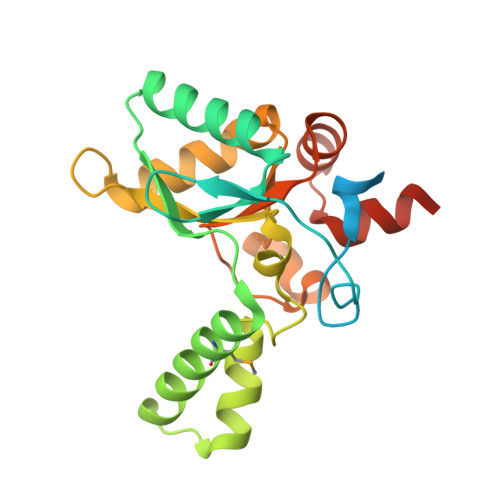Structural basis for the substrate recognition of peptidoglycan pentapeptides by Enterococcus faecalis VanYB.
Kim, H.S., Hahn, H., Kim, J., Jang, D.M., Lee, J.Y., Back, J.M., Im, H.N., Kim, H., Han, B.W., Suh, S.W.(2018) Int J Biol Macromol 119: 335-344
- PubMed: 30016658
- DOI: https://doi.org/10.1016/j.ijbiomac.2018.07.081
- Primary Citation of Related Structures:
5ZHF, 5ZHW, 6A6A - PubMed Abstract:
Vancomycin resistance in Enterococci and its transfer to methicillin-resistant Staphylococcus aureus are challenging problems in health care institutions worldwide. High-level vancomycin resistance is conferred by acquiring either transposable elements of the VanA or VanB type. Enterococcus faecalis VanY B in the VanB-type operon is a d,d-carboxypeptidase that recognizes the peptidyl-d-Ala 4 -d-Ala 5 extremity of peptidoglycan and hydrolyses the terminal d-Ala on the extracellular side of the cell wall, thereby increasing the level of glycopeptide antibiotics resistance. However, at the molecular level, it remains unclear how VanY B manipulates peptidoglycan peptides for vancomycin resistance. In this study, we have determined the crystal structures of E. faecalis VanY B in the d-Ala-d-Ala-bound, d-Ala-bound, and -unbound states. The interactions between VanY B and d-Ala-d-Ala observed in the crystal provide the molecular basis for the recognition of peptidoglycan substrates by VanY B . Moreover, comparisons with the related VanX and VanXY enzymes reveal distinct structural features of E. faecalis VanY B around the active-site cleft, thus shedding light on its unique substrate specificity. Our results could serve as the foundation for unravelling the molecular mechanism of vancomycin resistance and for developing novel antibiotics against the vancomycin-resistant Enterococcus species.
Organizational Affiliation:
Research Institute of Pharmaceutical Sciences, College of Pharmacy, Seoul National University, Seoul, Republic of Korea; Therapeutic Target Discovery Branch, Division of Precision Medicine, National Cancer Center, Goyang, Gyeonggi, Republic of Korea; Department of Chemistry, College of Natural Sciences, Seoul National University, Seoul, Republic of Korea. Electronic address: hskim@ncc.re.kr.



















